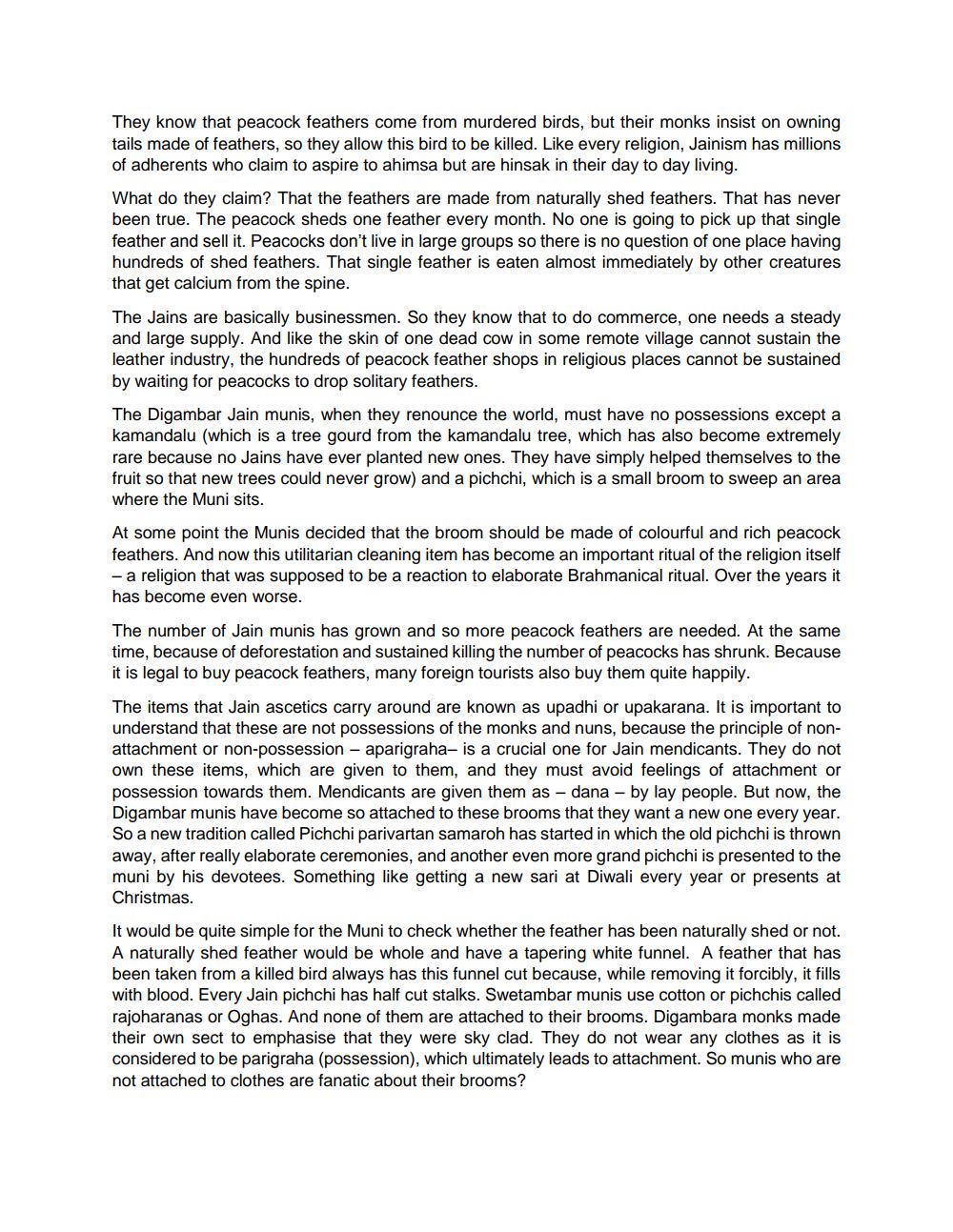________________
They know that peacock feathers come from murdered birds, but their monks insist on owning tails made of feathers, so they allow this bird to be killed. Like every religion, Jainism has millions of adherents who claim to aspire to ahimsa but are hinsak in their day to day living. What do they claim? That the feathers are made from naturally shed feathers. That has never been true. The peacock sheds one feather every month. No one is going to pick up that single feather and sell it. Peacocks don't live in large groups so there is no question of one place having hundreds of shed feathers. That single feather is eaten almost immediately by other creatures that get calcium from the spine.
The Jains are basically businessmen. So they know that to do commerce, one needs a steady and large supply. And like the skin of one dead cow in some remote village cannot sustain the leather industry, the hundreds of peacock feather shops in religious places cannot be sustained by waiting for peacocks to drop solitary feathers. The Digambar Jain munis, when they renounce the world, must have no possessions except a kamandalu (which is a tree gourd from the kamandalu tree, which has also become extremely rare because no Jains have ever planted new ones. They have simply helped themselves to the fruit so that new trees could never grow) and a pichchi, which is a small broom to sweep an area where the Muni sits.
At some point the Munis decided that the broom should be made of colourful and rich peacock feathers. And now this utilitarian cleaning item has become an important ritual of the religion itself - a religion that was supposed to be a reaction to elaborate Brahmanical ritual. Over the years it has become even worse.
The number of Jain munis has grown and so more peacock feathers are needed. At the same time, because of deforestation and sustained killing the number of peacocks has shrunk. Because it is legal to buy peacock feathers, many foreign tourists also buy them quite happily.
The items that Jain ascetics carry around are known as upadhi or upakarana. It is important to understand that these are not possessions of the monks and nuns, because the principle of nonattachment or non-possession - aparigraha, is a crucial one for Jain mendicants. They do not own these items, which are given to them, and they must avoid feelings of attachment or possession towards them. Mendicants are given them as - dana - by lay people. But now, the Digambar munis have become so attached to these brooms that they want a new one every year. So a new tradition called Pichchi parivartan samaroh has started in which the old pichchi is thrown away, after really elaborate ceremonies, and another even more grand pichchi is presented to the muni by his devotees. Something like getting a new sari at Diwali every year or presents at Christmas.
It would be quite simple for the Muni to check whether the feather has been naturally shed or not. A naturally shed feather would be whole and have a tapering white funnel. A feather that has been taken from a killed bird always has this funnel cut because, while removing it forcibly, it fills with blood. Every Jain pichchi has half cut stalks. Swetambar munis use cotton or pichchis called rajoharanas or Oghas. And none of them are attached to their brooms. Digambara monks made their own sect to emphasise that they were sky clad. They do not wear any clothes as it is considered to be parigraha (possession), which ultimately leads to attachment. So munis who are not attached to clothes are fanatic about their brooms?




